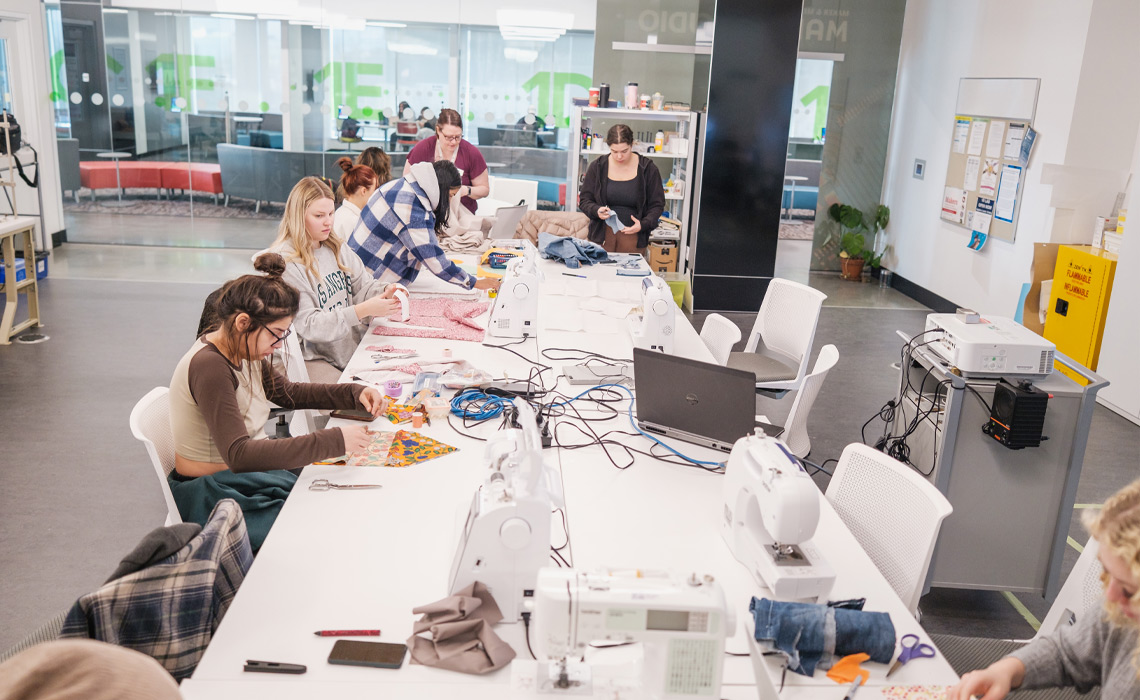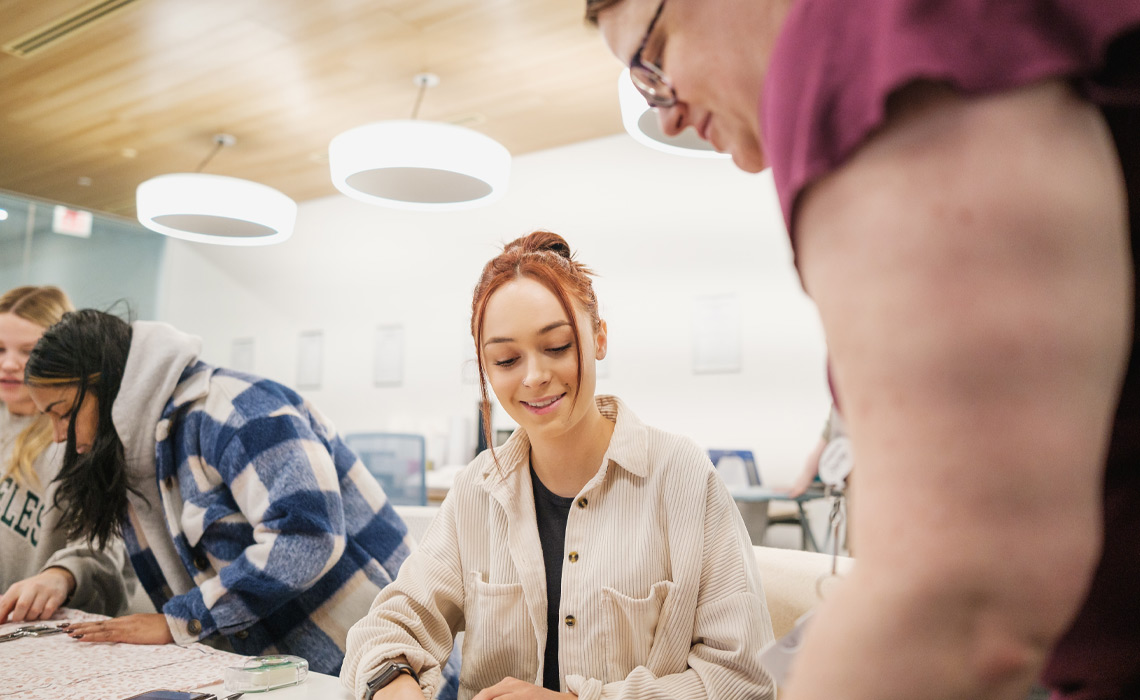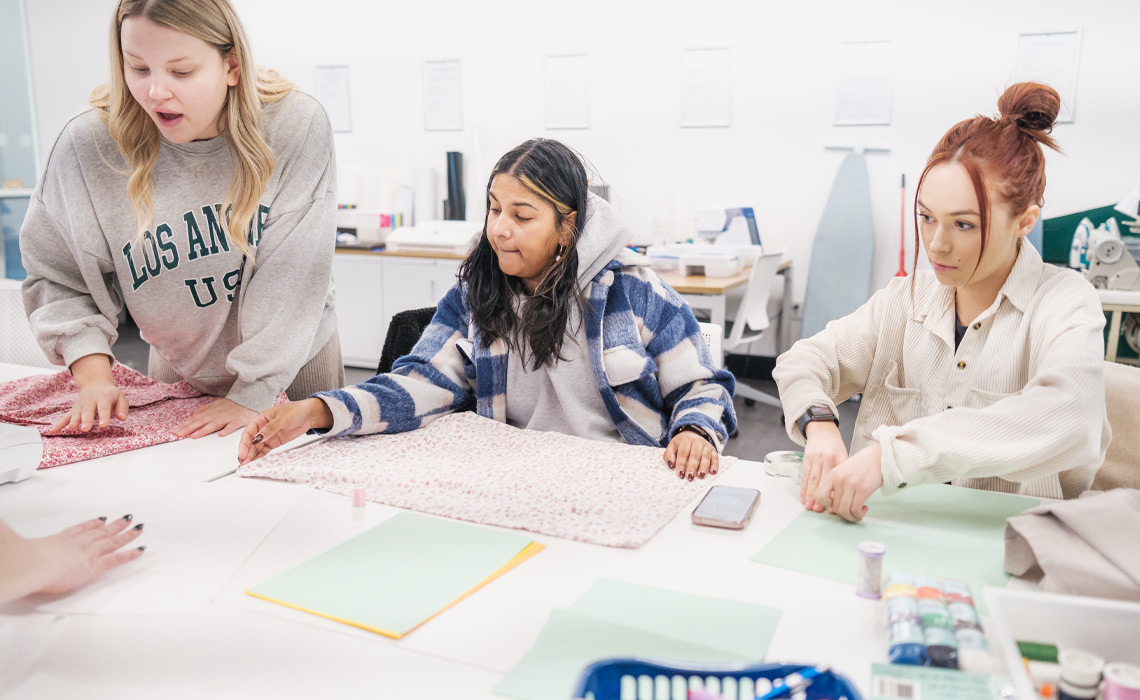Sootsiman project shares knowledge and culture

When Sara Atiyeh left her Syrian homeland for Canada she packed a bag of belongings.
Of course, there were the essentials required for relocation to pursue a post-secondary education in a far away land that she took with her. But there was also more meaningful baggage, tangible and intangible, related to her culture, friends and family — treasured possessions she would physically leave behind but carry with her always.
“I couldn’t leave with everything,” the fourth-year Mount Royal University Child and Youth Care Counsellor student explains, but she has since found something that could help in the future.
MRU Bachelor of Child Studies students participate in a sootsiman project, which is an Indigenous-inspired, hands-on experience that Atiyeh can relate to.
Building upon the Blackfoot tradition, the capstone project sees pupils create their own sootsiman, or decorated rawhide bag. The intent behind it is two-fold: to produce something from scratch and something symbolic using everything from paint and beads to embroidery and authentic Indigenous materials.
Each student, working on the project in Mount Royal Library’s Maker & Media Commons, personalized their work by including written, graphic and symbolic representations of their learnings and personal growth.
The Library is a key partner, playing a supportive role in teaching and learning through its leading-edge spaces, support and equipment as a place for curricular enrichment for faculty and students.
Users can explore new ideas and design concepts at the Maker & Media Commons while experimenting with immersive tools and technologies. They have access to everything from pioneering research to a variety of equipment including 3D-printing tools, cutting tools, electronics and robotics — all offering an alternative way of understanding and exploring new ideas and concepts and a different way of problem solving.
“The students came in with a wide range of experience, so they did a lot of sharing knowledge and helping each other as they created their sootsiman,” says Brenna Burwash, a collection service technician on the Maker Studio team.
“I demonstrated how to use the sewing machines and provided troubleshooting when needed. Since every student designed their own sootsiman, it was a collaborative project to develop a pattern and sew it.”
Every sootsiman is unique given every student decides what to put inside. The sootsiman becomes a keepsafe for accumulated knowledge about the world and themselves encapsulated within an Indigenous tradition.

Atiyeh repurposed an old pair of jeans, with the resulting sootsiman an interesting patchwork of soft, well-worn denim. There is even a pocket on the outside.
“I was really happy to have not just a bag but the meaning behind whatever we incorporate into it,” she says. “You pick what you want and you carry it with you.”
Atiyeh has hand-written notes and a book, entitled The Comfort Crisis by Michael Easter, inside her sootsiman, something she plans to cherish long after she graduates from MRU.
“I’ll keep it with me to symbolize and represent all my learning as a little piece of Canada, in a sense,” the 23-year-old says.
Sharing the sootsimans of our hearts
Elder Roy Bear Chief (known in Blackfoot as espoom tah or "helper"), is with MRU’s Faculty of Health, Community and Education, and works with the Department of Child Studies and Social Work to assist students with their creations.
Students and faculty are honoured to be exposed to his teachings and Bear Chief cherishes the opportunity.
“I look at it as sharing my language and culture,” he says.
Way, way back, Bear Chief says, a sootsiman was made of animal hide fashioned into a pouch or large envelope, which was then taken on trips or when hunting to carry food — often dry meat — and other essentials.
He says it’s exciting to see students transforming the tradition into something purposeful in their own lives. The project, he adds, is like a modern-day version of the sootsiman.
The Siksika Nation Elder says everyone, with or without a tangible sootsiman, carries one in their heart. It is, he explains, all the lessons we hang on to.
“During our lifetime journey we come across many things such as words of advice we hear from older people or anybody in general. Words of wisdom or things we read. You take a three-hour lecture and hear what the instructor is teaching you,” he says. “You take things of importance at home, at work, at play. You take all those things and put it into your sootsiman so, at some point, you may be sitting there reflecting on things you have learned and can open up their sootsiman and retrieve it.”

He says Siksika Elders often say life is about looking, listening and learning, and sometimes, lessons aren’t always appreciated in the moment. But if you’re lucky, it’s stored in a sootsiman to be unpacked later.
Bear Chief says, ideally, each MRU student’s sootsiman will serve as a keepsake to remind them of their journey, almost like a journal.
“The idea is it helps to represent who they are,” says Carolyn Bjartveit, associate professor, Faculty of Health, Community and Education. “They can choose the fabrics and materials and decorate it according to their own wishes and interests and what they want to reflect about themselves. They are really beautifully decorated.”
As part of the project, students researched authentic materials and Indigenous designs while reflecting on their own personal stories through an Indigenous lens.
Bjartveit says students looked at Glenbow Museum sootsiman collections and images of artifacts but relied on guidance and input from Bear Chief, too.
Not a lot of information exists in literature given much of Indigenous history relies on oral tradition, she adds.
“The sootsiman, in terms of the capstone, is symbolic of life-long teachings or learning you put in a bundle,” she says. “So, when the course ends, you are taking away these teachings. It can include stories from the Elder, from knowledge holders, literature, curriculum or even impactful conversations in the classroom.”
Bjartveit says there is something special about integrating a hands-on approach to learning and students creating their own designs with elements of things they love from family to nature.
“I think creating the physical piece brought the teachings to life in many ways,” she says. “There were pictures of mountains and trees and how the students represented growth and learning. Those kinds of symbolism came through from their own research and exploration and discussions with Elder Bear Chief.
“It was just a wonderful experience to work with Elder Bear Chief,” she adds. “His teachings are so powerful and brought so much learning to life.”
The projects engaged students, and in a meaningful way, “infused Indigenous teachings” into their education.
Instructor Katharin Pritchard guides fourth-year students through the sootsiman capstone project.
She says the departure from the more traditional way of learning in a university setting is a way for students to identify their strengths, talents and skills.
“I like it because it is used as a metaphor for something,” she says. “It’s just a different way, a creative way of doing things. It engages more than the mind.
“Some students last fall had never been in front of a sewing machine. They were so thrilled to make something,” Pritchard adds, and that the learning they have from the capstone has changed entire world views in some cases.
“It’s been so powerful,” she says. “The Indigenous perspective, to me, is a nicer, kinder, more caring way of looking at people and the world. The earth, the plants and everything is connected to us and how we treat those is how this world will be. That (perspective) is critical to all students’ learning.”
Read more about Child Studies at Social Work and the Riddell Library and Learning Centre at MRU.
